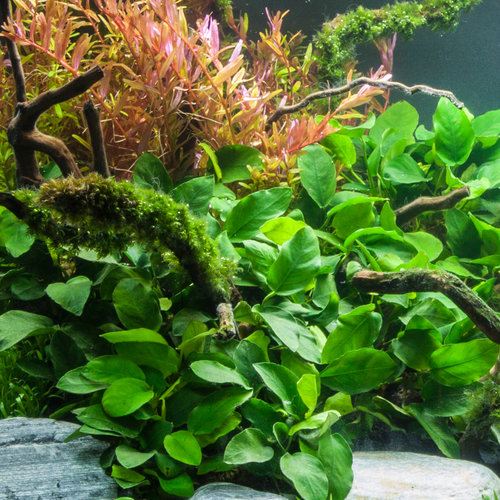Discover the beauty and simplicity of Anubias Barteri Nana with this comprehensive beginner's guide. Learn how to care for this popular aquarium plant and create a stunning aquatic environment.
What is Anubias Barteri Nana?
Anubias Barteri Nana is a popular aquatic plant that is commonly used in aquariums. It belongs to the Anubias genus, which is known for its hardy and low-maintenance nature. Anubias Barteri Nana is a small, compact variety of Anubias that is perfect for beginners. It has lush green leaves that add a touch of beauty to any aquarium.
This plant is native to West Africa, where it grows along rivers and streams. It is often found attached to rocks or driftwood, making it an excellent choice for aquascaping. Anubias Barteri Nana is a slow-growing plant, which means it requires minimal trimming and upkeep.
One of the unique features of Anubias Barteri Nana is its ability to tolerate a wide range of water conditions. It can thrive in both low-light and high-light environments, making it suitable for various types of aquarium setups. Additionally, this plant is known for its ability to absorb nutrients from the water column, which helps to improve water quality and reduce algae growth.
Benefits of Adding Anubias Barteri Nana to Your Aquarium
There are several benefits to adding Anubias Barteri Nana to your aquarium:
1. Enhances the aesthetic appeal: The lush green leaves and compact size of Anubias Barteri Nana create a visually pleasing underwater landscape. It adds a natural and vibrant touch to any aquarium.
2. Provides hiding spots for fish: The broad leaves of Anubias Barteri Nana provide excellent hiding spots for small fish and invertebrates. It helps to create a sense of security and reduces stress in your aquatic pets.
3. Oxygenates the water: Like other aquatic plants, Anubias Barteri Nana releases oxygen during photosynthesis. This helps to oxygenate the water and create a healthier environment for your fish.
4. Natural algae control: Anubias Barteri Nana competes with algae for nutrients in the water, helping to control and reduce algae growth in your aquarium.
5. Easy to care for: Anubias Barteri Nana is a low-maintenance plant that does not require frequent pruning or special attention. It can thrive in a wide range of water conditions, making it suitable for beginners.
Choosing the Right Tank Setup for Anubias Barteri Nana
When setting up your aquarium for Anubias Barteri Nana, there are a few key factors to consider:
1. Lighting: Anubias Barteri Nana can survive in low to moderate light conditions. However, for optimal growth and vibrant coloration, provide moderate to high lighting. LED lights with a color temperature of around 6500K are recommended.
2. Substrate: This plant can be attached to rocks, driftwood, or planted in the substrate. If you choose to plant it in the substrate, use a nutrient-rich substrate or insert root tabs to provide essential nutrients.
3. Water parameters: Anubias Barteri Nana can tolerate a wide range of water parameters. The ideal temperature is between 72-82°F (22-28°C), and the pH should be slightly acidic to slightly alkaline (6.0-7.5). Maintain good water quality by performing regular water changes and using a reliable filtration system.
4. Placement: Consider the size of your aquarium and the growth habits of Anubias Barteri Nana when deciding on its placement. It is best to leave some space between each plant to allow for proper growth and prevent overcrowding.
By providing the right tank setup, you can ensure that your Anubias Barteri Nana thrives and adds beauty to your aquarium.
Essential Care Tips for Anubias Barteri Nana
To keep your Anubias Barteri Nana healthy and thriving, follow these essential care tips:
1. Lighting: As mentioned earlier, provide moderate to high lighting for optimal growth and coloration. Avoid direct sunlight, as it can cause algae growth.
2. Water parameters: Maintain stable water parameters within the recommended range. Regularly test the water for temperature, pH, and ammonia levels. Make necessary adjustments to keep the water conditions suitable for your plant.
3. Fertilization: Anubias Barteri Nana is not a heavy feeder but can benefit from occasional fertilization. Use a liquid aquarium fertilizer or root tabs to provide essential nutrients. Be careful not to over-fertilize, as it can lead to algae problems.
4. Pruning: Anubias Barteri Nana is a slow-growing plant that requires minimal pruning. Remove any dead or yellowing leaves to maintain its aesthetic appeal. Do not trim the rhizome, as it can lead to plant death.
5. Algae control: Although Anubias Barteri Nana helps to control algae growth, it is still susceptible to algae if conditions are not favorable. Regularly clean the aquarium, maintain good water flow, and avoid overfeeding to prevent algae issues.
By following these care tips, you can enjoy a healthy and vibrant Anubias Barteri Nana in your aquarium.
Propagation Techniques for Anubias Barteri Nana
Anubias Barteri Nana can be propagated through the following techniques:
1. Rhizome division: Carefully separate the rhizome into sections, ensuring that each section has at least a few leaves and healthy roots. Plant the divided sections in suitable locations in your aquarium.
2. Leaf cuttings: Select healthy leaves with a portion of the rhizome attached. Cut the leaf into smaller sections, making sure each section has a portion of the rhizome. Plant the cuttings in the substrate or attach them to rocks or driftwood.
3. Tissue culture: Anubias Barteri Nana is also available in tissue culture form, which involves growing the plant in a laboratory under sterile conditions. Tissue culture plants are free from pests and diseases and can be a convenient way to add new specimens to your aquarium.
Regardless of the propagation technique you choose, it is important to provide suitable conditions and care for the newly propagated plants until they establish themselves.
Additional Resources:
Live Aquarium Plants | Ultimate Guide To Live Aquarium Plants
Unveiling The Truth: Cyrptocoryne Plants
Exploring The Beauty Of Dwarf Sagittaria
Planting Live Aquarium Plants - How To Guide




Leave a Comment